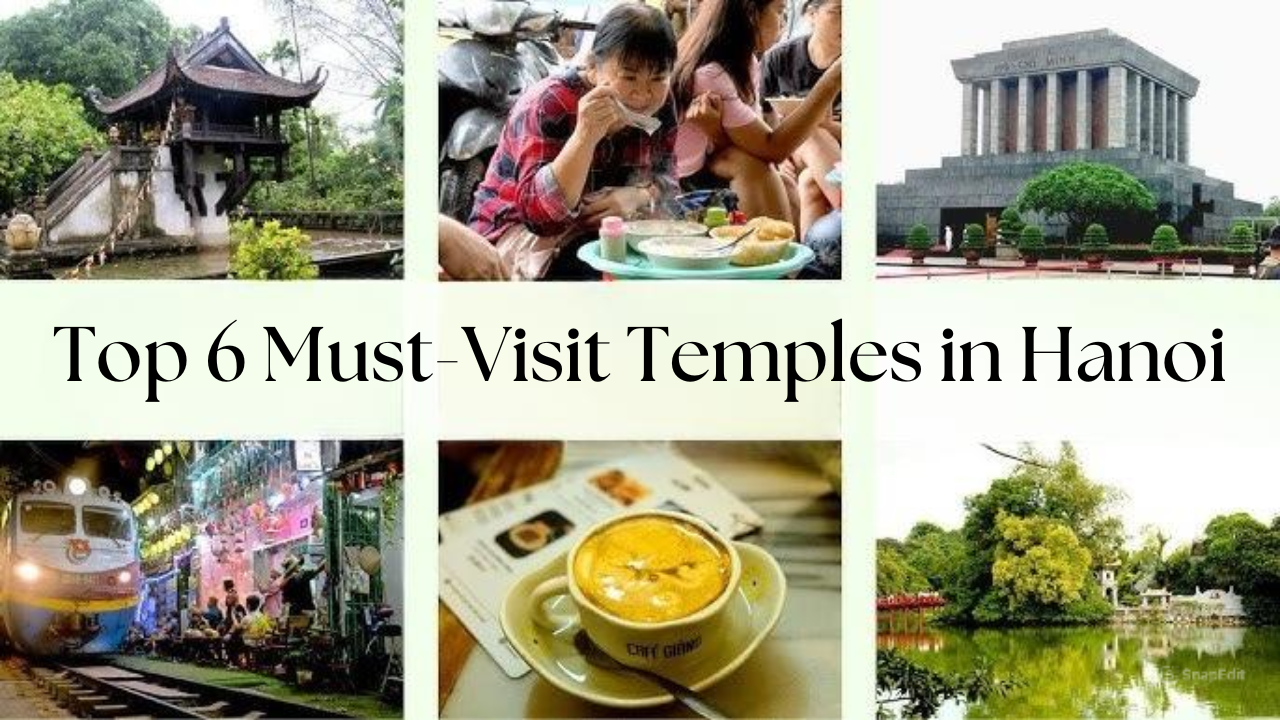Top 6 Must-Visit Temples in Hanoi for a Spiritual and Cultural Heritage Journey
The 6 Must-Visit Temples in Hanoi, Vietnam
Whether you are a history lover, a spiritual seeker, or simply a traveler looking for unique experiences, these top 6 must-visit temples in Hanoi will give you a deeper understanding of the city’s past and present.
Differences between Pagodas and Temples in Vietnam’s Culture
In Vietnam’s spiritual culture, pagodas (chua) are Buddhist worship places, maintained by monks and nuns, where people pray for peace and enlightenment. They feature Buddha statues, stupas, and bell towers, hosting Buddhist rituals like chanting and meditation. Temples (den, mieu, phu, dinh) honor deities, national heroes, or ancestors, blending folk beliefs, Confucianism, and Taoism.
Managed by local communities or spirit mediums, temples have altars, ancestral tablets, and dragon motifs, with rituals focused on offerings and protection. While pagodas emphasize Buddhist teachings, temples serve historical commemoration and folk worship, both deeply embedded in Vietnam’s religious and cultural identity.
Phu Tay Ho – The Sacred Mother Goddess Temple
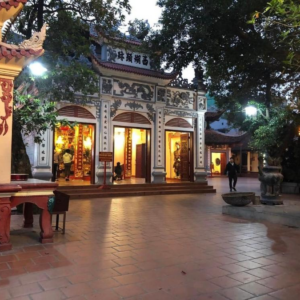
Location & History
- Address: Dang Thai Mai Street, Tay Ho District, Hanoi
- Established: 17th century
- Dedicated to: Saint Mother Lieu Hanh
- Opening Hours: 6:00 AM – 6:00 PM
Phu Tay Ho was built to honor Saint Mother Lieu Hanh, a revered figure in Vietnamese folk religion. She is believed to bring prosperity, protect families, and bless businesses. The temple is an important center for the worship of Mother Goddesses, a practice deeply rooted in Vietnamese culture and recognized by UNESCO as an Intangible Cultural Heritage.
Architectural and Cultural Significance
The temple features intricate wooden carvings and traditional Vietnamese motifs, reflecting the artistic craftsmanship of past centuries. Its strategic location by the water enhances its serene and sacred atmosphere. During important festivals, the temple hosts elaborate ceremonies, drawing large crowds who come to participate in traditional rituals and performances.
How to Visit Phu Tay Ho
Best Time to Visit
Phu Tay Ho is busiest on the first and fifteenth days of the lunar month when many people come to make offerings. To experience the temple’s peaceful ambiance, visit early in the morning or late in the afternoon. Sunset over West Lake provides a particularly beautiful backdrop for the temple.
Etiquette and Dress Code
- Dress modestly, covering shoulders and knees, as a sign of respect.
- Offerings such as flowers, fruits, and incense are commonly brought by visitors.
- Photography is allowed in the courtyard but should be done respectfully without disturbing worshippers.
Nearby Dining Recommendations
West Lake Shrimp Cake (Banh Tom Ho Tay)
- Location: 1 Thanh Nien Street, Tay Ho District
- Description: A Hanoi specialty consisting of crispy shrimp fritters served with fresh herbs and a tangy dipping sauce. This dish pairs well with a view of West Lake.
Fried Tofu with Shrimp Paste (Bun Dau Mam Tom)
- Location: 235B Thuy Khue Street, Tay Ho District
- Description: A popular Vietnamese street food featuring crispy fried tofu, vermicelli noodles, boiled pork, and fermented shrimp paste. Ideal for those looking to try bold flavors.
Rolled Pho Noodles (Pho Cuon)
- Location: 33 Ngu Xa Street, Ba Dinh District
- Description: Soft rice noodle sheets wrapped around stir-fried beef and fresh herbs, served with a sweet and tangy dipping sauce. A great alternative to traditional pho.
Quan Thanh Temple – The Guardian of Hanoi’s North
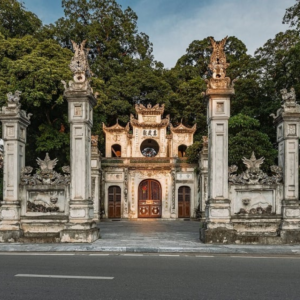
Location & History
- Address: 8 Thanh Nien Street, Ba Dinh District, Hanoi
- Established: 11th century (during the Ly Dynasty)
- Dedicated to: Tran Vu, the Taoist guardian deity of Hanoi’s north
- Opening Hours: 8:00 AM – 5:00 PM
Quan Thanh Temple is one of the Four Sacred Temples of Thang Long, built to protect the ancient capital from malevolent spirits. It was originally known as Tran Vu Temple, named after the deity it enshrines. Over centuries, the temple has undergone several renovations, blending architectural styles from different dynasties while maintaining its historical integrity.
Architectural and Cultural Significance
Quan Thanh Temple is an outstanding example of Taoist temple architecture in Vietnam, combining elements of Chinese and Vietnamese design. The entrance is marked by an ornate three-arched gate, leading visitors into a peaceful courtyard shaded by ancient banyan trees. Inside, the temple features:
- A colossal 4-ton bronze statue of Tran Vu, cast in the 17th century. This intricately sculpted figure is one of the largest and most impressive Taoist statues in Vietnam.
- Delicate wood carvings and calligraphy reflecting the artistry of Vietnam’s imperial past.
- A sacred turtle sculpture, symbolizing wisdom and longevity, often visited by worshippers seeking guidance and good fortune.
The temple remains an active place of worship, where locals come to pray for protection, success, and peace. It is particularly busy during Lunar New Year celebrations and Taoist festivals.
How to Visit Quan Thanh Temple
Best Time to Visit
Quan Thanh Temple is best visited in the morning or late afternoon, when the temple grounds are quieter, and the lighting is ideal for photography. The atmosphere is especially mystical on foggy or overcast days, enhancing the temple’s ancient and spiritual ambiance.
Etiquette and Dress Code
- As it is a religious site, visitors should dress modestly, covering shoulders and knees.
- Respect temple rules by remaining quiet and refraining from flash photography inside the prayer halls.
- If participating in rituals, observe how locals make offerings and follow their lead.
Nearby Dining Recommendations
Bun Rieu Cua Hang Bac (Crab Noodle Soup)
- Location: 11 Hang Bac Street, Hoan Kiem District
- Description: A refreshing noodle soup made with freshwater crab broth, tomatoes, tofu, and rice vermicelli, topped with fresh herbs.
Bun Cha Hang Quat (Grilled Pork with Vermicelli)
- Location: 74 Hang Quat Street, Hoan Kiem District
- Description: The dish made famous by Anthony Bourdain and Barack Obama, featuring grilled pork patties served with rice noodles, fresh herbs, and a dipping sauce.
– Kem Trang Tien (Trang Tien Ice Cream)
- Location: 35 Trang Tien Street, Hoan Kiem District
- Description: A historic ice cream parlor offering classic Vietnamese flavors such as coconut, green bean, and chocolate.
Kim Lien Temple – The Southern Guardian of Hanoi
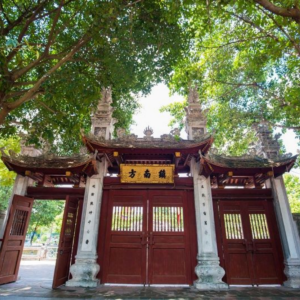
Location & History
- Address: Kim Lien Ward, Dong Da District, Hanoi
- Established: 15th century (during the Ly Dynasty)
- Dedicated to: Cao Son Dai Vuong, the guardian deity of the southern part of ancient Hanoi
- Opening Hours: 7:00 AM – 5:30 PM
Kim Lien Temple was built to honor Cao Son Dai Vuong, a deity believed to protect the city from southern invaders and natural disasters. Over centuries, it has been a place of worship for both locals and travelers seeking spiritual blessings, protection, and peace. The temple is particularly lively during the Kim Lien Festival, held annually in the second lunar month. The festival includes traditional rituals, folk performances, and offerings, drawing visitors from across the country.
Architectural and Cultural Significance
Kim Lien Temple showcases a unique blend of Vietnamese and Chinese architectural influences, reflecting the craftsmanship of the Ly and Tran dynasties. Some of its most remarkable features include:
- A three-gate entrance leading to a large courtyard with ancient banyan trees.
- Wooden carvings and lacquered altars, illustrating the artistry of past dynasties.
- A sacred stone stele, recording the temple’s history and importance in the protection of Thang Long.
- Ornate dragon sculptures and lotus motifs, symbolizing prosperity and purity.
How to Visit Kim Lien Temple
Best Time to Visit
The best time to visit Kim Lien Temple is during the early morning or late afternoon, when the atmosphere is calm, and the lighting is perfect for photography. The temple is especially vibrant during the Kim Lien Festival, but visiting during quieter periods offers a more meditative experience.
Etiquette and Dress Code
- Wear modest clothing, covering your shoulders and knees, as a sign of respect.
- If making an offering, bring flowers, incense, or traditional Vietnamese cakes.
- Maintain silence while inside the main prayer hall to respect worshippers.
Nearby Dining Recommendations
Bun Thang (Vietnamese Chicken Noodle Soup)
- Location: 48 Cau Go Street, Hoan Kiem District
- Description: A delicate noodle soup featuring shredded chicken, egg, pork sausage, and aromatic broth. A must-try for those looking for a light yet flavorful dish.
Banh Cuon Thanh Van (Steamed Rice Rolls)
- Location: 14 Hang Ga Street, Hoan Kiem District
- Description: Thin steamed rice rolls filled with seasoned pork and mushrooms, served with sweet and savory dipping sauce.
Xoi Yen (Sticky Rice with Toppings)
- Location: 35B Nguyen Huu Huan Street, Hoan Kiem District
- Description: A popular breakfast dish with sticky rice topped with mung beans, fried shallots, and your choice of meats.
Temple of Literature – The First University of Vietnam
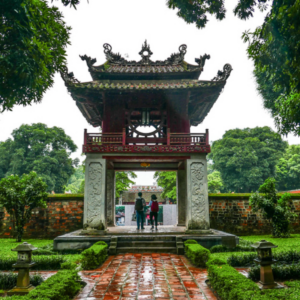
Location & History
- Address: 58 Quoc Tu Giam Street, Dong Da District, Hanoi
- Established: 1070 (Temple), 1076 (Imperial Academy – Quốc Tử Giám)
- Dedicated to: Confucius, scholars, and Vietnam’s finest intellectuals
- Opening Hours: 8:00 AM – 5:30 PM
The Temple of Literature was initially built as a Confucian temple, but in 1076, Emperor Ly Nhan Tong expanded it to establish Quoc Tu Giam, the first national university in Vietnam. For centuries, it educated the nation’s most talented scholars and mandarins, fostering generations of intellectuals. Although the university ceased operation in the early 20th century, the site remains a symbol of Vietnam’s academic tradition and pursuit of knowledge.
Architectural and Cultural Significance
- First Courtyard (Dai Trung Mon Gate): A peaceful entrance surrounded by lush gardens, representing the beginning of a scholar’s journey.
- Second Courtyard (Khue Van Cac – The Pavilion of Constellation): A stunning red-and-gold pavilion, considered the symbol of Hanoi’s scholarly tradition.
- Third Courtyard (Thien Quang Well and the Stelae of Doctors): Home to 82 stone stelae, each mounted on a stone turtle, honoring scholars who passed the royal exams. These stelae are recognized by UNESCO as a World Documentary Heritage.
- Fourth Courtyard (Great House of Ceremonies): Houses the main Confucius altar and ancestral tablets dedicated to great scholars.
- Fifth Courtyard (Quoc Tu Giam – The Imperial Academy): Once the training ground for the country’s brightest minds, now a space showcasing Vietnam’s education history.
How to Visit the Temple of Literature
Best Time to Visit
The Temple of Literature can be visited year-round, but the best time is during spring (January – March) when students and families visit to pray for academic success before exams. The early morning or late afternoon hours provide the best lighting and a quieter experience.
Etiquette and Dress Code
- Wear modest clothing, as this is a place of cultural significance.
- Maintain silence in ceremonial areas to respect worshippers and visitors.
- Photography is allowed, but avoid flash photography in sacred spaces.
Ngoc Son Temple – The Iconic Temple on Hoan Kiem Lake
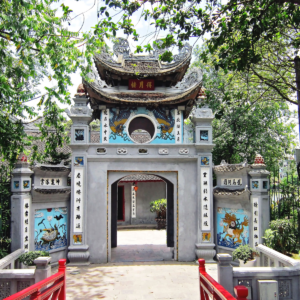
Location & History
- Address: Hoan Kiem Lake, Hoan Kiem District, Hanoi
- Established: 19th century (earlier structures existed in the 13th century)
- Dedicated to: General Tran Hung Dao, the God of Literature, and La To (the patron of physicians)
- Opening Hours: 7:00 AM – 6:00 PM
Ngoc Son Temple, which translates to the Temple of the Jade Mountain, was built in honor of General Tran Hung Dao, a revered military leader who defeated the Mongol invasions in the 13th century. It also pays tribute to Van Xuong, the God of Literature, and La To, the patron deity of medicine. The temple’s location on Hoan Kiem Lake (Lake of the Returned Sword) is tied to the legendary tale of Emperor Le Loi and the magical sword, which he returned to the sacred Golden Turtle after liberating Vietnam from Chinese rule.
Architectural and Cultural Significance
- The Huc Bridge (Cau The Huc) – A striking red wooden bridge leading to the temple, symbolizing sunlight and prosperity.
- Pen Tower (Thap But) – A stone tower shaped like a calligraphy brush, representing the importance of literature and knowledge.
- Dai Nghien (Ink Slab Gate) – A stone ink slab atop three supporting toads, emphasizing the value of education.
- The Main Temple Hall – Houses altars dedicated to General Tran Hung Dao, Van Xuong, and La To, along with ceremonial artifacts and ancient texts.
- The Preserved Giant Turtle – A large taxidermy soft-shell turtle displayed inside, believed to be linked to the Hoan Kiem legend.
How to Visit Ngoc Son Temple
Best Time to Visit
The temple is busiest during weekends and holidays, especially around Lunar New Year when locals come to pray for success and good fortune. To avoid crowds, visit early in the morning or late in the afternoon when the lake and temple take on a magical, tranquil atmosphere.
Etiquette and Dress Code
- Wear modest clothing, covering shoulders and knees, as a sign of respect.
- Keep noise levels low, as many visitors come for spiritual reasons.
- Photography is allowed, but be mindful in sacred areas.
Nearby Dining Recommendations
Ngoc Son Temple is located in Hanoi’s Old Quarter, making it easy to explore some of the city’s most famous street food and traditional dishes after your visit.
Pho Thin (Hanoi Beef Noodle Soup)
- Location: 13 Lo Duc Street, Hai Ba Trung District
- Description: A famous Hanoi-style pho known for its rich, smoky broth and stir-fried beef slices.
Banh Mi 25 (Vietnamese Baguette Sandwich)
- Location: 25 Hang Ca Street, Hoan Kiem District
- Description: Freshly baked banh mi filled with pate, grilled pork, pickled vegetables, and herbs.
Egg Coffee at Café Giang
- Location: 39 Nguyen Huu Huan Street, Hoan Kiem District
- Description: A must-try Vietnamese specialty, featuring a creamy layer of whipped egg yolk over strong coffee.
Bach Ma Temple – The Oldest Temple in Hanoi
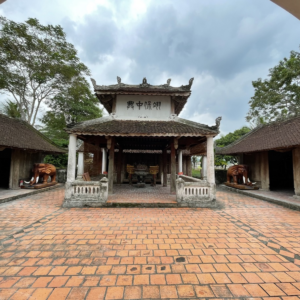
Location & History
- Address: 76 Hang Buom Street, Hoan Kiem District, Hanoi
- Established: 9th century (during the Ly Dynasty)
- Dedicated to: Long Do, the Guardian Deity of Hanoi
- Opening Hours: 7:00 AM – 5:30 PM
Bach Ma Temple, meaning “White Horse Temple”, is associated with an ancient legend. According to historical accounts, when Emperor Ly Thai To decided to move the capital to Thang Long (now Hanoi), he struggled to build the city walls. One night, a white horse appeared in his dream, galloping around the area. The emperor took this as a divine sign and ordered the walls to be built according to the horse’s path. The construction was successful, and in gratitude, he built Bach Ma Temple to honor the White Horse deity.
Over the centuries, the temple has undergone several renovations, particularly during the Tran, Le, and Nguyen dynasties, yet it has maintained its ancient charm and spiritual importance.
Architectural and Cultural Significance
- The Main Shrine: Houses an altar dedicated to the White Horse deity, surrounded by red and gold lacquered wood carvings.
- Ancient Roof and Courtyard: The temple’s curved roof, intricate pillars, and courtyard reflect the imperial architecture of past dynasties.
- Historical Artifacts: Includes royal decrees, ancient wooden doors, and sacred statues, showcasing its historical value.
- A Sacred White Horse Statue: Symbolizing the guardian spirit of Hanoi, this statue is the focal point of worship.
How to Visit Bach Ma Temple
Best Time to Visit
Bach Ma Temple is open year-round, but the best time to visit is during the early morning or late afternoon to avoid the crowds. If you visit during Tet (Vietnamese New Year) or major Buddhist festivals, you’ll witness lively ceremonies and local traditions.
Etiquette and Dress Code
- Dress modestly, covering shoulders and knees, as a sign of respect.
- Speak quietly and avoid loud conversations inside the prayer halls.
- Offerings such as flowers, incense, or fruits are welcome but not required.
- Photography is allowed, but avoid using flash inside the main shrine.
Nearby Dining Recommendations
Bun Thang (Vietnamese Chicken Noodle Soup)
- Location: 48 Cau Go Street, Hoan Kiem District
- Description: A delicate and flavorful noodle soup with shredded chicken, eggs, pork sausage, and fragrant broth. Often considered Hanoi’s most elegant noodle dish, it is a must-try for those looking for authentic flavors.
Cha Ca La Vong (Hanoi Turmeric Fish with Dill)
- Location: 14 Cha Ca Street, Hoan Kiem District
- Description: Hanoi’s famous grilled fish dish, served sizzling with fresh dill, peanuts, and vermicelli noodles. A dish so legendary that the entire street was named after it.
Fish Noodles (Bun Ca Hanoi)
- Location: 5 Trung Yen Alley, Hoan Kiem District
- Description: A lighter and tangy noodle soup featuring crispy fried fish, tomatoes, and fresh herbs. Perfect for those who enjoy seafood flavors.
Sugarcane Juice (Nuoc Mia) near Bach Ma Temple
- Location: Street stalls around Bach Ma Temple, Hang Buom Street
- Description: A refreshing drink made from freshly pressed sugarcane, served with ice and a hint of kumquat. Ideal for cooling off after exploring the Old Quarter.
Conclusion
Hanoi’s rich cultural and spiritual heritage is beautifully reflected in its centuries-old temples. From the tranquil Phu Tay Ho to the historic Bach Ma Temple, each site offers a unique glimpse into Vietnam’s religious traditions, history, and architecture. Whether you are looking to pray for prosperity, explore ancient legends, or admire breathtaking architecture, these six must-visit temples will leave you with a deeper appreciation of Hanoi’s past and present. Exploring these temples is more than just sightseeing—it’s a journey into the heart of Vietnam’s spiritual and cultural identity. Take your time to enjoy the peaceful atmosphere, learn about local traditions, and soak in the beauty of these sacred sites.
Ready to experience Hanoi’s most sacred sites? Don’t forget to capture unforgettable moments, taste authentic Hanoi cuisine, and immerse yourself in the city’s rich history. For more travel tips, hidden gems, and must-visit destinations in Vietnam, visit VNITourist.com today!
